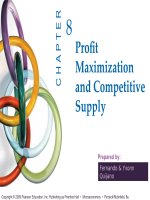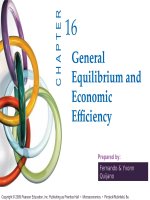- Trang chủ >>
- Đại cương >>
- Kinh tế vi mô
bài giảng kinh tế vi mô tiếng anh ch10 equilm & econ welfare
Bạn đang xem bản rút gọn của tài liệu. Xem và tải ngay bản đầy đủ của tài liệu tại đây (51.97 KB, 6 trang )
1
Chapter 10
General Equilibrium and
Economic Welfare
Key issues
1. general equilibrium
2. Pareto principal
3. efficiency and equity
Partial equilibrium analysis
• an examination of equilibrium and changes
in equilibrium in one market in isolation
• problem: by holding prices and quantities of
other goods fixed, we ignore possibility that
events in this market affect other markets'
equilibrium prices and quantities
• doing so is OK for small markets (hoola
hoops)
General-equilibrium analysis
• study of how equilibrium is determined in
all markets simultaneously an event in one
market may have a spillover effect on other
markets may be linked
• through demand
• through supply
• because output in one market is an input in
another
Compromise between partial and
general equilibrium
study equilibrium in several - but not all -
markets simultaneously
Feedback between competitive
markets
• corn and soybean markets are linked
• consumers substitute between corn and
soybeans
• producers substitute between corn and
soybeans
2
Sequence of events
• shock in corn market affects soy market
• resulting shift in the soy market affects corn
market
• diminishing reverberations occur until
markets settle at new equilibria
• whether nearly instantaneously or not
depends on reaction speeds of consumers
and producers
Suppose
• Foreign demand for American corn
decreases
• export of corn falls by 10% at the current
price
• Total American demand for corn shifts left
Figure 10.1a Relationship Between the Corn and Soybean
Markets
Price, $
per bushel
Corn, Billion bushels per year
e
0
c
e
1
c
e
3
c
D
0
c
D
1
c
S
3
c
S
0
c
$215
$1.9171
$1.9057
8.448.26138.227
(a) Corn Market
Figure 10.1b Relationship Between the Corn and Soybean
Markets
Price, $
per bushel
Soybeans, Billion bushels per year
e
0
s
e
2
s
e
4
s
D
4
s
D
2
s
S
4
s
S
2
s
S
0
s
D
0
s
$4.12
$3.8325
$3.8180
2.072.05142.0505
(b) Soybean Market
Partial equilibrium bias in corn
market is small
2.1%11.4%general equilibrium
2.5%10.8%partial equilibrium
Drop in quantityDrop in price
3
Sin taxes
• justification for taxes on alcohol, tobacco,
and other goods and services with poor
reputations
• they raise revenues for the government
• they discourage bad behavior
• do these taxes significantly affect other
markets?
General equilibrium tax effects
• study of general equilibrium effects of
alcohol and tobacco taxes on 13 goods and
services
• suppose a $1.3 billion shortfall in drug
rehabilitation programs is paid for by higher
cigarette and alcohol taxes
Effect of tax on government
revenues
• $1.29 billion rise (partial equilibrium)
• $772 million rise due to changes in taxes
collected from other sectors (general
equilibrium)
• Thus, partial-equilibrium analysis overstates
the increase in tax revenues by two-thirds
Minimum wage
• complete coverage (partial-equilibrium
analysis): minimum wage causes
unemployment (Puerto Rico)
• incomplete coverage (general-equilibrium
analysis)
• wage differentials across sectors
• no unemployment
U.S. minimum wage
• first minimum wage law passed in 1938
• Fair Labor Standards Act
• incomplete coverage: exempted agriculture,
government, most retail, most service
• economists joked that its purpose was to maintain
family farms
• law drove workers out of manufacturing and other
covered industries into agriculture and other
uncovered sectors
Effect of incomplete coverage
• minimum wage in covered sector causes
employment in that sector to fall
• workers who lose their jobs move to the
uncovered sector
• minimum wage leads to wage differential
between sectors – not unemployment
4
Uncovered sector supply curve
residual supply curve: market supply not met by
demanders in other sectors at any given wage:
S
u
(w) = S(w) - D
c
(w)
• w = wage
• w = minimum wage
• S
u
(w) = uncovered sector residual supply
• S(w) = total supply curve
• D
c
(w) = demand for labor in covered sector
Figure 10.02 Minimum Wage with Incomplete Coverage
w, Wage
per hour
w, Wage
per hour
w, Wage
per hour
L, Annual hours
(a) Covered Sector (b) Uncovered Sector (c) Total Labor Market
w
1
w
2
w
S
L
c
2
L
c
1
L
u
2
L
u
1
L
c
1
L
u
1
L
1
= +
D
c
D
u
S
u
D
L
c
, Annual hours L
u
, Annual hours
88%86%61%56%
» 50%
19911978196219471938
Share uncovered by minimum wage
today: all industry/government sectors are covered,
but coverage in agriculture and private household
employment is incomplete
Solved problem
• government starts subsidizing the cost of labor by
a payment of s per hour only in a covered sector
• wage received by workers in both sectors is w, but
the wage paid by firms in the covered sector is
w – s
• What effect does the subsidy have on wages, total
employment, and employment in covered and
uncovered sectors of the economy?
Solved Problem 10.1
w, Wage
per hour
w, Wage
per hour
w, Wage
per hour
L, Annual hours
(a) Covered Sector (b) Uncovered Sector (c) Total Labor Market
w
1
w
1
w
2
w
1
w
2
w
2
s
S
L
c
2
D
2
c
D
1
c
L
c
1
L
u
2
L
u
1
L
1
L
2
e
2
e
1
D
u
L
c
, Annual hours L
u
, Annual hours
D
1
D
2
Welfare
society decides whether a particular
equilibrium (or change in equilibrium) is
desirable by answering 2 questions:
• Is the equilibrium efficient?
• Is the equilibrium equitable?
5
Efficiency
• production efficiency: cannot produce more
output at current cost given current
knowledge
• consumption efficiency: goods cannot be
reallocated across people so that at least
someone is better off and no one is harmed
Pareto principle
allows us to rank different allocations of
goods and services where no interpersonal
comparisons need to be made
Pareto efficient
any allocation where we cannot make one
person better off without harming another
person is Pareto efficient
First theorem of welfare
economics
any competitive equilibrium is Pareto efficient
Second theorem of welfare
economics
any Pareto-efficient equilibrium can be
obtained by competition, given an
appropriate endowment
Socially desirable decision-
making system
• should satisfy
• social preferences should be complete and transitive, as
are individual preferences
• if everyone prefers Allocation a to Allocation b, then a
should be socially preferred to b
• society's ranking of a and b should depend only on
individuals' ordering of these two allocations (not on
how they rank other alternatives)
• dictatorship not allowed: social preferences must
not reflect preferences of only a single individual
6
Arrow’s Impossibility Theorem
• it is impossible to find a social decision
making rule that always satisfies all of these
criteria
• his result indicates that democratic decision
making may fail - not that democracy must
fail
Choices of three people
bacthird choice
acbsecond choice
cbafirst choice
321Individual:
1. General equilibrium
• shock in one market has spillover effect in
another market
• general-equilibrium analysis takes account
of spillover unlike partial-equilibrium
analysis
• partial-equilibrium and general-equilibrium
analyses give different answers if spillover
effects are large
2. Pareto efficiency
competition produces Pareto efficiency









